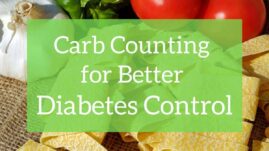The glycemic index is a popular term in the diabetes world, especially in the United States.
But how does the glycemic index relate to healthy eating, and especially healthy eating for people with diabetes? What does it do and how does it matter?
This article will outline exactly what the glycemic index is, what it does, and how using it can be a great tool for you and your diabetes management.
What is the glycemic index?
The glycemic index, or GI for short, is a system of scoring food on a scale of 1-100. Every food has a score, and the lower the score, the longer that particular food takes to raise a person’s blood sugar levels, regardless of whether or not they have diabetes.
The GI specifically indicates how quickly carbohydrate-laden foods raise blood sugar levels, compared to pure glucose (which had a score of 100).
The glycemic index is not a specific diet, but rather a tool and eating plan that people can use to help better guide their food choices to make healthier decisions.
Foods on the GI scale come in three categories:
- Low GI: 1 to 55
- Medium GI: 56 to 69
- High GI: 70 and higher
Several factors influence the glycemic index of a food, including the nutrient composition, cooking method, ripeness/readiness to eat, and the amount of processing a certain food has undergone.
As an example, an English muffin made with white flour has a GI value of 77, whereas the whole-wheat alternative has a GI value of only 45.
Routinely choosing foods with lower GI can lead to improved health outcomes and improved quality of life, especially if you live with diabetes.
Glycemic index vs. glycemic load
The glycemic index is only part of the story. It doesn’t tell you how high your blood sugar will go when you eat, just how fast it will rise.
The “glycemic load” also takes the glucose per serving into account to give you an accurate picture of how your blood sugar will be affected by the food you eat.
Watermelon, for example, has a relatively high glycemic index of 80, but a single serving (one cup) of watermelon only has 11 carbohydrates, giving it a glycemic load of only 5.
This means that a serving of watermelon will make your blood sugar rise quickly but not very high.
How is the glycemic index helpful for people with diabetes?
Eating foods while being cognizant of their GI is helpful for many reasons.
Mainly, it helps people stabilize their blood sugar levels (even if they don’t have diabetes), and reduce the total amount of carbohydrates they consume. It can also help people:
- Lose weight
- Maintain weight
- Reduce the risk of heart disease
- Improve sleep quality
- Improve energy levels
- May reduce the risk of cancer
- Reduce cholesterol
- Improve blood sugar stability (even if a person doesn’t have diabetes)
A meta-analysis of 24 studies showed that for every 5 GI points in a given food, the risk of developing type 2 diabetes for a person increased by 8%.
Eating foods according to their glycemic index (and eating foods with a lower glycemic index in general) can help people with diabetes drastically improve their blood sugar levels, lower their hba1c, and improve their overall quality of life.
Studies have shown that eating primarily low glycemic foods may also lead to weight loss in individuals with diabetes, which can help to improve insulin sensitivity and prevent insulin resistance.
Blood sugars are also easier to manage by eating lower GI foods, which may help improve mental health, prevent diabetes burnout, and reduce anxiety around fluctuating blood sugar levels.
What foods should I eat on a low GI diet?
Always work with your primary care physician before starting a new eating plan, but a good low GI diet will consist of a lot of the following:
- Fruits and berries: cherries, strawberries, blueberries, raspberries, lemons, limes, grapefruit
- Non-starchy vegetables: broccoli, onion, brussels sprouts, cauliflower, carrots, spinach, kale, avocado
- Beans and legumes: lentils, black beans, navy beans, chickpeas, kidney beans
- Meat: chicken, beef, bison, lamb, pork, turkey
- Seafood: tuna, salmon, shrimp, anchovies, sardines
- Oils: extra virgin olive oil, coconut oil
- Nuts and seeds: cashews, almonds, macadamia nuts, walnuts, chia seeds, sesame seeds, flax seeds
- Any herbs and spices
Although no foods are off-limits on a GI eating plan, foods with a high GI should be limited.
What foods should I avoid on a low GI diet?
If following a low GI diet, you will want to avoid foods that have a high glycemic index, such as:
- Cereals: instant oatmeal and breakfast cereals
- Bread: white bread, pita bread, bagels, pizza crust
- Rice: white rice
- Pastas: lasagna, spaghetti, macaroni, ravioli
- Starchy vegetables: any form of white potatoes (including potato chips and fries)
- Desserts and sweets: donuts, ice cream, cake, muffins, cupcakes, cookies, chocolate
- Sugar-sweetened beverages: soda, fruit juice (even 100% juice), sports and energy drinks, sweetened milk, milkshakes
What are the drawbacks of a low GI diet?
Being cognizant of the glycemic index of foods you’re consuming, especially if you have diabetes, can be a super healthy way to eat. However, there can be some drawbacks to the eating plan.
The GI plan doesn’t take into account other macronutrients, like fat and protein. It is also important to consider the total amount of carbohydrates you’re eating, not solely GI, to help manage blood sugars and predict glycemic load.
Minding total fiber and total added sugars to the foods you’re consuming is important as well, especially when determining how much insulin or oral diabetes medication to take if you live with diabetes.
For instance, the glycemic index of a serving of french fries is 75 and the GI of a baked potato is 93.
Following this plan would have a person eating fries over a potato, when it’s important to take into consideration the vitamins, minerals, and fiber that a potato provides that are crucial elements to a person’s diet as well.
Another difficulty of this eating plan is that the GI scale measures individual foods, when most foods are parts of recipes and meals.
This can make determining the total GI of an entire meal more difficult, and harder to follow and stick with when eating meals outside of the home.
Additionally, the GI eating plan doesn’t take into account portion sizes, so a good, low GI food may not be appropriate in large portions (whole wheat bread or berries, for example), which can wreak havoc on blood sugar levels.
Changing your eating plan may alter your medication needs, so speak with your doctor before making any adjustments to your insulin and/or oral diabetes medications.
Conclusions
In short, following a low glycemic eating plan means swapping higher GI foods for lower GI food alternatives.
The eating plan is proven to help people achieve better health outcomes, including lower cholesterol, improved blood sugar levels, lower hba1c levels, weight loss, improved heart health, and more.
However, the eating plan can be hard to follow, especially with meals eaten out at restaurants and away from the home.
The diet also does not take into account protein, fats, added sugars, fiber, or total carbohydrates eaten, which is especially important for people with diabetes who are juggling the management of food and meals with medication, exercise, sleep, and stress management.
It is important to consume a healthy diet with lots of variety, focusing mostly on whole and unprocessed foods, regardless of their glycemic index.
And as always, work with your primary care physician or endocrinologist before making any changes to your diet, eating plan, or medication regimen.




Mary Pat McGowan
Interesting article on the glycemic index. What would be a good reference on foods and there glycemic content.
Christel Oerum, MS
You can either Google the food you want to look up or use one of the many glycemic index list online. This is one option: https://glycemic-index.net/glycemic-index-chart/